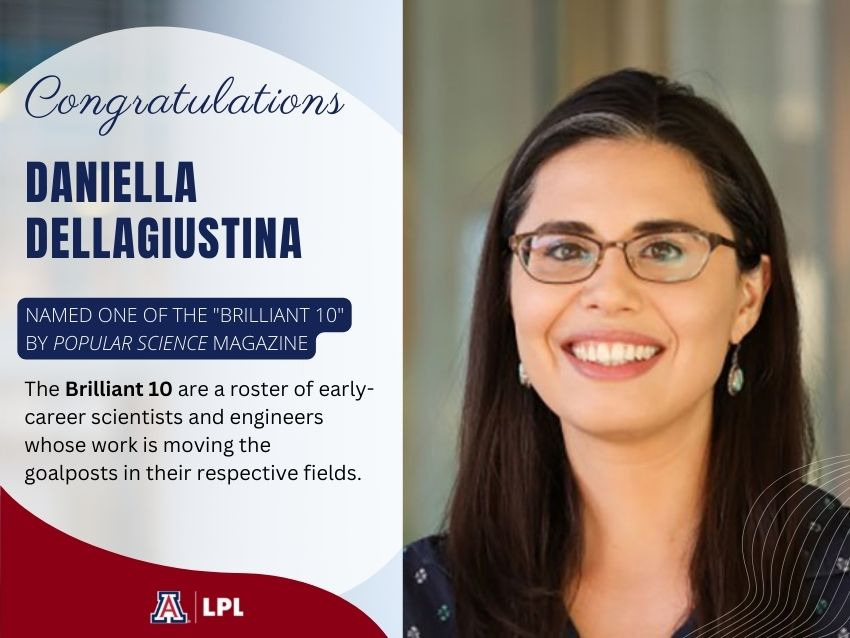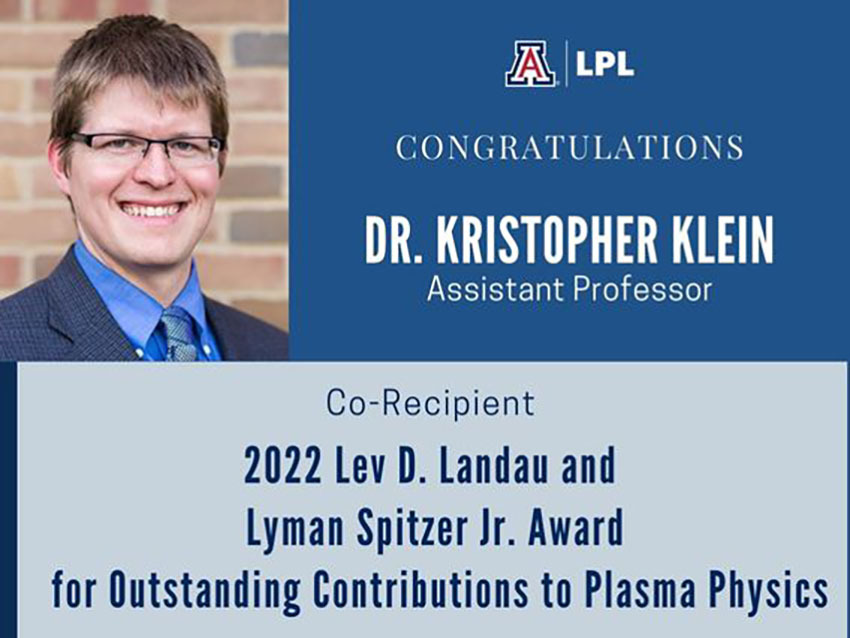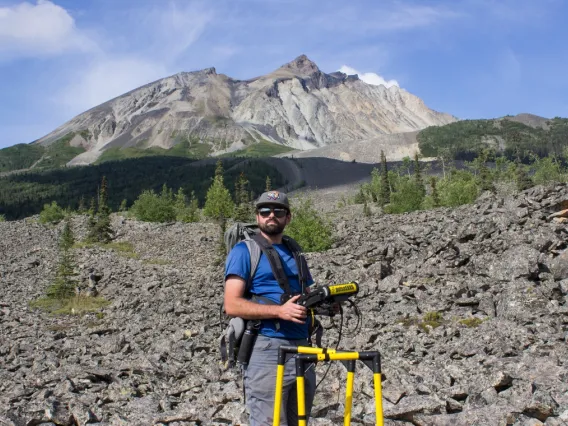
Mapping Rock Glaciers to Understand Their Future on Earth and Mars
University of Arizona researchers developed a new method for analyzing rock glaciers, which could help scientists better understand these "hidden giants" on Earth and Mars.
Mapping Rock Glaciers to Understand Their Future on Earth and Mars
×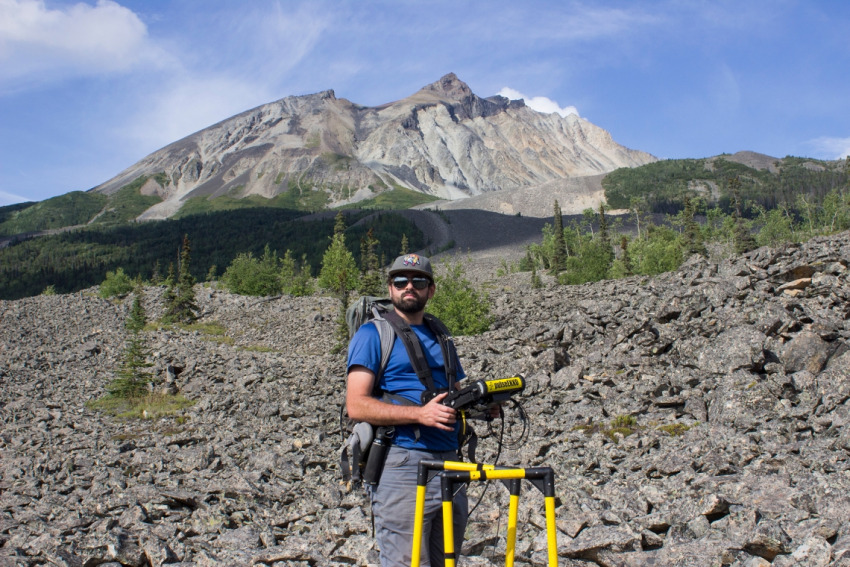
By Mikayla Mace Kelley, University Communications - November 16, 2022
Standing on a rock glacier is what Tyler Meng imagines it would be like to stand on the surface of Mars. The glacier's barren and wrinkled landscape looks like Silly Putty that's drooped under gravity's pull, offering few clues that a frozen, debris-laden giant lurks beneath the surface.
Rock glaciers are so named because unlike pure ice glaciers, they are a mix of frozen water, sand and rocks. They are generally found at the base of steep mountainsides or cliffs that have slowly dropped rock debris, which then mixes with glacier ice and refrozen snowmelt. Rock glaciers also exist on Mars.
Meng – who is pursuing a doctoral degree in planetary science at the University of Arizona, with a minor in geosciences – is lead author of a study in the Journal of Glaciology that describes a new method to determine rock glaciers' ice thickness and the ratio of ice to debris, allowing for more precise measurements of these glaciers than previously possible. Meng and his adviser and co-author Jack Holt, a UArizona planetary sciences and geosciences professor, used this information to create maps of four rock glaciers in Colorado, Wyoming and Alaska.
Their work, and future work that uses this method, will allow scientists to better understand water resources on both Earth and Mars, as well as how resilient this type of buried ice will be to the changing climate on both planets.
More than ice
Rock glaciers are hidden and insulated by debris on top of ice, and their movement is affected by the rocks trapped inside of them.
"You can think of the rocks like an insulating blanket," Meng said. "Beyond a certain thickness, insulation basically turns off the melting, allowing for the ice to be preserved and slowly move or flow down a valley at elevations and temperatures where clean ice may be completely melted."
Both pure ice glaciers and rock glaciers can move across landscapes – very slowly. However, the debris in rock glaciers causes them to flow even more slowly than ice glaciers, as the inclusion of rocks makes them much stiffer. They're also typically smaller and thinner than clean ice glaciers, measuring just a couple miles in length, a few hundred or thousand feet wide and between 50 and 200 feet thick. Ice glaciers, in contrast, can be many miles in length and thousands of feet thick.
To collect the information needed to map and characterize these hidden giants, Meng, Holt, other UArizona students and their collaborators hiked rugged mountain terrain in the western U.S., lugging computers, battery packs and radar antennas on their backs. They navigated steep landscapes with loose rocks ranging in size from grains of sand to houses.
"Standing on a debris-covered glacier is pretty surreal, because it's in this barren area on a mountainside, and each rock glacier seems to have its own personality," Meng said. "They each have a slightly different type of bedrock supplying debris, and the valley geometry dictates its shape and appearance."
Using two different antenna configurations, the researchers used ground-penetrating radar to measure both the radar wave speed and the angle at which the wave was reflected from the subsurface. In the same way that humans have two eyes to see in three dimensions, two antenna configurations allowed the researchers to better calculate the dimensions of the rock glacier. They also estimated the ratio of ice to rock at each survey location using radar wave velocity.
"In the process, we made the most precise estimates of rock glacier geometry and composition to date," Meng said.
From Earth to Mars
Understanding rock glaciers on Earth is important because they are essentially water reservoirs, Meng said.
"Our research gives us a better idea of the total water budget in mountainous regions, where major rivers have headwaters," he said. "Snow is a year-to-year accumulation that covers an entire landscape, whereas rock glaciers are a more localized but permanent water reservoir that actually stores water for what could be hundreds to a few thousand years."
The researchers are continuing their analysis to understand signs of past climate change in rock glaciers and how these glaciers might have evolved through past climate changes.
"By having a map of the debris thickness and ice concentration, we can essentially characterize the ability of rock glaciers to withstand effects of a warming climate compared to clean ice glaciers," Meng said.
Other scientists also recognized rock glaciers on Mars by their wrinkled putty-like flow pattern, even before radar data detected them.
Martian rock glaciers are still not well understood, Meng said, but it is known that they are typically found between 30 and 60 degrees latitude in both of the planet's hemispheres and are much older than the Martian polar ice.
"These Martian rock glaciers are potential targets for water resources on Mars, too, because they're actually really large compared to the ones on Earth, like hundreds of meters thick," Meng said. "They're also more accessible than polar ice because spacecraft wouldn't have to change their orbits as much as they would if they were to land on a pole, which requires a lot more fuel to reach."
One of the big challenges for scientists is determining the thickness of the surface rock covering the glaciers on Mars. If there is 30 feet of rock and debris on rugged Martian terrain, then it might not be worth the trouble for astronauts to attempt to access the ice for water resources, Meng said.
"Our goal is to use these rock glaciers on Earth as an analog for processes on Mars," Meng said. "By mapping the patterns of debris thickness on Earth, we're trying to understand how that debris thickness may also vary on Mars. Also, by learning about the differences in flow parameters between clean ice and debris-rich ice, that will help simulations for the Martian case as well."
Moving forward, Holt's research group is continuing to make similar measurements using surface-based radar while collecting new data using drones. This drone-based data collection will help the group to gain a more complete understanding of rock glacier flow and subsurface characteristics, while also testing new geophysical methods that may be used in future exploration of Earth and Mars.
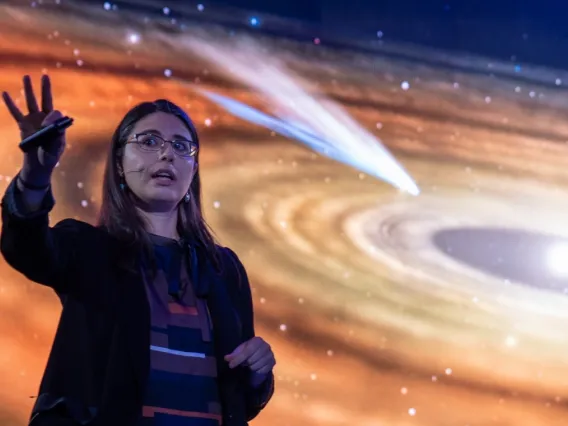
Planetary Scientist Dani DellaGiustina Makes Popular Science Brilliant 10
University of Arizona planetary scientist Dani DellaGiustina was chosen because of her work to understand the past and future of the solar system by studying asteroids. Her work also includes exploring the mysterious interiors of other worlds.
Planetary Scientist Dani DellaGiustina Makes Popular Science Brilliant 10
×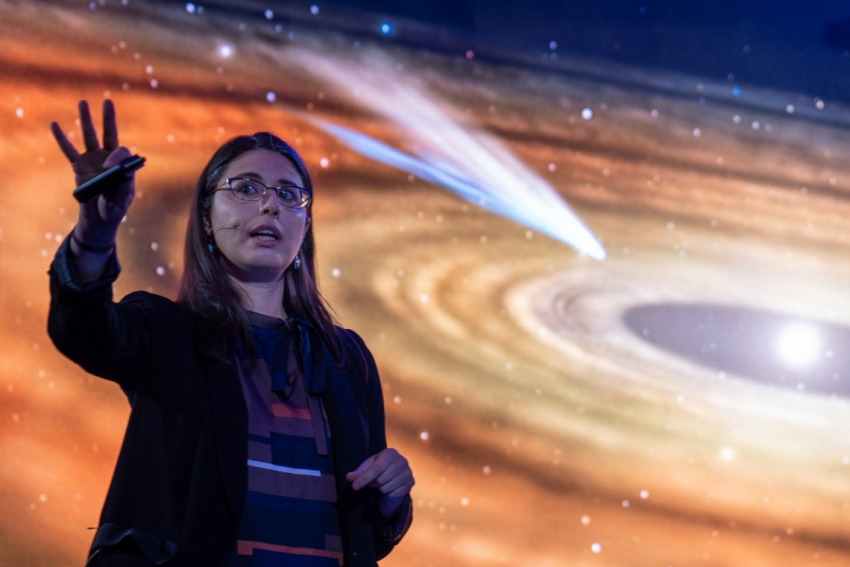
By Mikayla Mace Kelley, University Communications - October 19, 2022
The University of Arizona's Daniella "Dani" DellaGiustina shot for the stars and has already landed among them. Today, the planetary scientist was named one of Popular Science's Brilliant 10 – an annual list of early-career scientists and engineers who are developing innovative approaches to problems across a range of disciplines.
DellaGiustina is an assistant professor of planetary sciences in the university's Lunar and Planetary Laboratory and deputy principal investigator of NASA's UArizona-led OSIRIS-REx asteroid sample return mission. She is also principal investigator of the extended OSIRIS-REx mission, dubbed OSIRIS-APEX, which will visit the near-Earth asteroid Apophis.
DellaGiustina was chosen from hundreds of researchers across a variety of institutions.
Popular Science says its list aims to recognize the hard work, creativity and potential of those who are shaking up old modes of thinking, defining new disciplines and laying the groundwork for tomorrow's most groundbreaking research.
"For the Brilliant 10, we look for innovative thinkers and leaders whose work stands to reshape our understanding of our world. The insights Daniella's work will glean from asteroids will do just that," said Popular Science Editor-in-Chief Corinne Iozzio. "When Apophis makes its loop around Earth in 2029, the work she's prepping now will ensure we learn everything we can about our past, present and future as we possibly can."
"Dr. DellaGiustina is a brilliant planetary scientist whose work on the OSIRIS-REx and OSIRIS-APEX missions is expanding our knowledge of the makeup of asteroids and is laying the foundation for groundbreaking discoveries about the evolution of our solar system," said Carmala Garzione, dean of the College of Science. "Her journey through her education and career is inspirational and will support the next generation of female and Latina scientists. We are proud to have Dr. DellaGiustina representing our science community in Southern Arizona."
DellaGiustina is interested in water distribution throughout the solar system and how scientists can establish water's presence on different planetary bodies.
"Over the last year, I've been enamored with the scientific questions to establish how water got to the early Earth billions of years ago," DellaGiustina said. "I'm also interested in understanding the interiors of asteroids, moons and planets, because it's so difficult to do. We only have indirect measurements and techniques at our disposal, so we must pair those measurements with good assumptions to fully interpret the data. I enjoy that challenge."
DellaGiustina develops and deploys remote-sensing instruments to learn more about the surface and interior structure of small airless worlds, including asteroids and the moons of the outer solar system, where liquid oceans could be lurking beneath ice sheets.
She tests her technology in places like Greenland, which has a landscape similar to the planetary bodies she studies. Over the summer, she spent several weeks testing instruments at a lake beneath a glacier in northwest Greenland, where half a mile of ice overlays about 30 feet of salty water, providing a similar landscape to what is expected on Jupiter's moon Europa.
Following the water has also taken her to asteroid Bennu, from which the OSIRIS-REx spacecraft collected a sample in 2020 that will be returned to Earth in 2023. Bennu contained evidence of water in its past, and so drew scientific attention. After the OSIRIS-REx spacecraft jettisons its sample return capsule over the Utah desert in September 2023, the spacecraft will fly on to study Apophis, thanks to a $200 million mission extension by NASA that DellaGiustina will lead. The goal of the OSIRIS-APEX extended mission is to understand what lies just beneath the surface of asteroid Apophis. Researchers also want to understand how Apophis will be physically affected by the gravitational pull of Earth when the asteroid make a close approach to the planet in 2029.
DellaGiustina, 36, has rocketed from student to principal investigator in a short period of time. She said that what motivates her is her love of discovery.
"I get obsessed with scientific questions and like treating them like giant puzzles," DellaGiustina said. "I also just love being the first person to see the first image of a planetary surface, or the first to discover what is at the base of an ice sheet. I'm hooked on that feeling."
DellaGiustina earned a bachelor's degree in physics from the University of Arizona in 2008. She got her master's in computational physics from the University of Alaska in 2011 and then returned to UArizona, where she completed a doctorate in geosciences in 2021.
Her career began to bud at the UArizona Lunar and Planetary Laboratory when she an undergraduate in the Arizona Space Grant program, studying meteorites with professor Dante Lauretta, who would become principal investigator for OSIRIS-REx.
Her work led to a student experiment on the Phase A Discovery OSIRIS Mission, which was a precursor to OSIRIS-REx that ultimately was not selected by NASA for spaceflight but paved the way for the OSIRIS-REx mission. She developed an experiment to measure the ability of asteroids to provide radiation shielding for future manned missions to Mars.
In graduate school, DellaGiustina combined remote observations of Earth's ice sheets with modeling techniques to understand how ice flow will respond to a changing climate. She now uses her knowledge of Earth's permanently frozen regions to perform field studies in Earth landscapes similar to icy bodies in the solar system.
In 2012, DellaGiustina became a research scientist in the UArizona Department of Physics, and she transitioned back to planetary sciences in early 2014. She led the OSIRIS-REx image processing team from 2015 to 2021 before becoming deputy principal investigator of the mission in 2021. In addition to her other roles, she teaches a course about asteroids and comets to undergraduate and graduate students.
"Being recognized as one of the Brilliant 10 is really rewarding because I am a Latina who has not taken a traditional path through my career," DellaGiustina said.
She put the pursuit of her doctoral degree on the backburner while she worked for a while to figure out exactly what she wanted to study — eventually settling on seismology. She finished her doctorate while working full time as a scientist, graduating the same semester she wrote the proposal that would lead to her appointment as the OSIRIS-APEX principal investigator. At the same time, she was growing a spaceflight seismometer instrument program at UArizona, called the Seismometer to Investigate Ice and Ocean Structure. The program develops instruments needed to support missions to icy bodies in the outer solar system that could provide a sneak peek into the interiors of other worlds.
"It's been a little bit of a gamble to do things in the way I have," DellaGiustina said, "so it's nice to get external recognition that the work I'm doing is impactful."
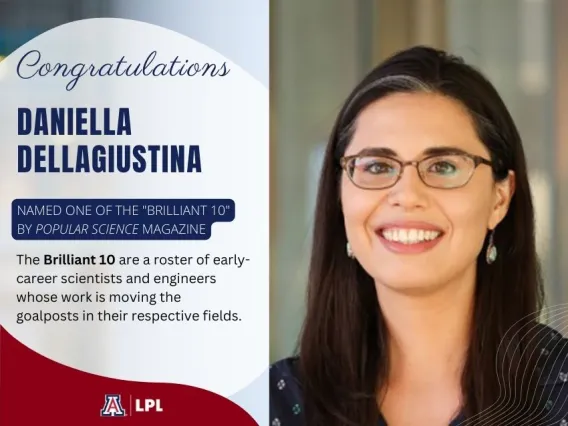
Daniella DellaGiustina Named One of the "Brilliant 10" by Popular Science
Assistant Professor Daniella DellaGiustina is named one of the "Brilliant 10 2022" by Popular Science Magazine.
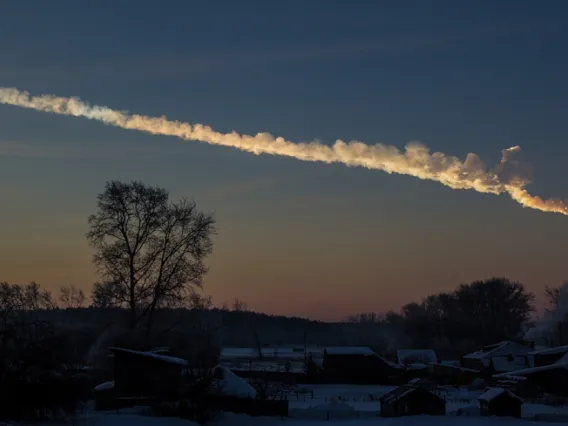
Scientists Identify Potential Source of 'Shock-darkened' Meteorites, with Implications for Hazardous Asteroid Deflection
University of Arizona planetary scientists identified a potential source of a special kind of meteorite. Its characteristics could explain certain discrepancies in how near-Earth asteroids are classified.
Scientists Identify Potential Source of 'Shock-darkened' Meteorites, with Implications for Hazardous Asteroid Deflection
×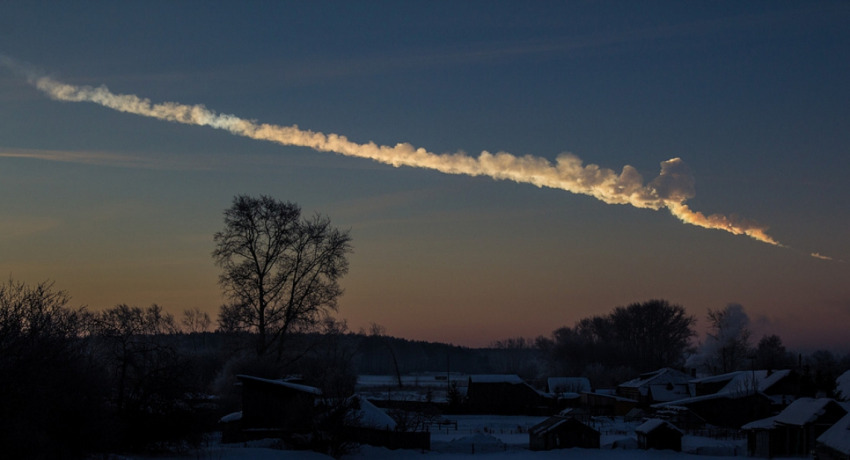
By Mikayla Mace Kelley, University Communications - October 4, 2022
When the Chelyabinsk fireball exploded across Russian skies in 2013, it littered Earth with a relatively uncommon type of meteorite. What makes the Chelyabinsk meteorites and others like them special is their dark veins, created by a process called shock darkening. Yet, planetary scientists have been unable to pinpoint a nearby asteroid source of these kinds of meteorites – until now.
In a new paper published in the Planetary Science Journal, University of Arizona scientists identified an asteroid named 1998 OR2 as one potential source of shock-darkened meteorites. The near-Earth asteroid is about 1 1/2 miles wide and made a close approach to Earth in April 2020. When pieces of asteroids break off into space and then land on Earth, they are considered meteorites.
"Shock darkening is an alteration process caused when something impacts a planetary body hard enough that the temperatures partially or fully melt those rocks and alter their appearance both to the human eye and in our data," said lead study author Adam Battle, a UArizona graduate student studying planetary science. "This process has been seen in meteorites many times but has only been seen on asteroids in one or two cases way out in the main asteroid belt, which is found between Mars and Jupiter."
Battle's adviser and study co-author Vishnu Reddy, a planetary sciences professor, discovered shock darkening on main belt asteroids in 2013 and 2014. Reddy co-leads the Space Domain Awareness lab at the Lunar and Planetary Laboratory with engineering professor Roberto Furfaro. Battle has worked in the lab since 2019.
"Impacts are very common in asteroids and any solid body in the solar system because we see impact craters on these objects from spacecraft images. But impact melt and shock-darkening effects on meteorites derived from these bodies are rare. Finding a near-Earth asteroid dominated by this process has implications for impact hazard assessment," Reddy said. "Adam's work has shown that ordinary chondrite asteroids can appear as carbonaceous in our classification tools if they are affected by shock darkening. These two materials have different physical strengths, which is important when trying to deflect a hazardous asteroid."
For this study, Battle, Reddy and their team used the RAPTORS system, a telescope atop the Kuiper Space Sciences building on campus, to collect data on 1998 OR2's surface composition and determined that it looked like an ordinary chondrite asteroid. Chondrite asteroids contain the minerals olivine and pyroxene and are lighter in appearance.
But when the team ran the data through a classification tool, it suggested the asteroid was instead a carbonaceous asteroid, a type of asteroid that is characteristically dark and relatively featureless.
"The mismatch was one of the early things that got the project going to investigate potential causes for the discrepancy," Battle said. "The asteroid is not a mixture of ordinary chondrite and carbonaceous asteroids, but rather it is definitely an ordinary chondrite, based on its minerology, which has been altered – likely through the shock darkening process – to look like a carbonaceous asteroid to the classification tool."
Shock darkening was hypothesized in the late 1980s but didn't gain traction and went unstudied until 2013 when the fireball over Russia produced meteorites with shock-darkened characteristics.
Scientists, including Reddy, started getting more interested in shock darkening, and Reddy soon discovered shock-darkened asteroids in the main asteroid belt. On Earth, 2%, or roughly 1,400 of about 60,000 ordinary chondrite meteorites have undergone some degree of shock or impact process, Battle said.
Researchers were able to rule out a lot of other potential reasons 1998 OR2 appeared to be a carbonaceous asteroid rather than an ordinary chondrite. One possible cause for the discrepancy could be space weathering, in which exposure to the space environment causes changes to the asteroid surface, but if that were the case, the asteroid would appear to be slightly redder in color than it is. Shock darkening is a process that can suppress the appearance of olivine and pyroxene while also darkening the asteroid's surface to look like a carbonaceous asteroid.
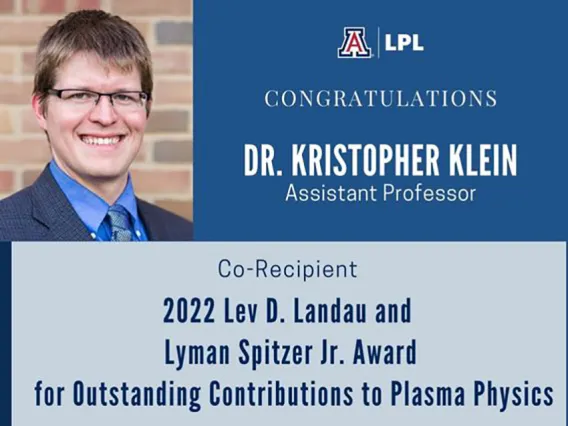
Kristopher Klein Receives 2022 Landau and Lyman Spitzer Jr. Award
Assistant Professor Kristopher Klein receives 2022 Lev D. Landau and Lyman Spitzer Jr. Award for Outstanding Contributions to Plasma Physics.

Science Diplomacy Students Present Climate Strategy to State Department
Students from various academic backgrounds applied their classwork to take real action against climate change.
Science Diplomacy Students Present Climate Strategy to State Department
×
By Mikayla Mace Kelley, University Communications - March 24, 2022
Individual actions are important to mitigate climate change, but more and more often, the general message has become: System-level change will have an even larger impact on the future. A group of University of Arizona students came together in the fall to drive change in this way.
Students in the Science Policy and Diplomacy class, taught by engineering professors Kevin Lansey and Hassan Vafai, teamed up with students in the Climate Change Adaptation class, taught by Gregg Garfin, an associate professor in the School of Natural Resources and the Environment. Together, they participated in a project hosted by the Diplomacy Lab – a public-private partnership between the U.S. Department of State and a network of U.S. academic institutions.
The Diplomacy Lab formalizes relationships between the U.S. Department of State and academic institutions so that faculty-led student teams can carry out research in collaboration with State Department officers around the world. Each semester, the Department of State provides approved university partners with a project menu of topics proposed by domestic bureaus and global embassies that can be undertaken by students of all different academic levels and disciplines.
Through a competitive process, teams bid for a research topic, and once the projects are assigned, the goal is for student groups to gain experience developing policy and presenting their recommendations to the State Department. The State Department can then use that information to inform policy change. The Diplomacy Lab was established in 2013, but the fall 2021 semester was the first time UArizona participated.
The UArizona students were assigned a project, developed under the Mekong-U.S. Partnership, that aims to find solutions to challenges in the region and to identify opportunities for the U.S. and the Mekong people and states. The students focused on improving food, energy and water security in Southeast Asia's Lower Mekong River Basin countries, which include Cambodia, Lao PDR, Myanmar, Thailand and Vietnam.
After months of research and brainstorming, four of the 12 students presented their policy recommendations in December via Zoom to Jung H. Pak, Deputy Assistant Secretary of State for Multilateral Affairs. The students outlined solutions to mitigate harm caused to the region by the changing climate, to reduce the carbon footprint of the people living there and to communicate these issues in innovative ways.
The Mekong River provides resources and services for 300 million people across Southeast Asia, but the ecosystem faces collapse from overfishing, unsustainable development and poor agricultural practices, according to Conservation International, an environmental nonprofit organization.
Recommendations for food, energy and water
At the beginning of the fall 2021 semester, the UArizona students divided into three teams to research and produce presentations to share with the State Department their research-based recommendations on three topics: food, energy and water.
The water team, which focused on the region's water quality, recommended installing new groundwater monitoring networks, expanding gender equity in water resource management, investing in flood disaster response and promoting eco-friendly farming practices.
"Going into the project, I knew vaguely about hydropower in the Mekong region," said water team member Jen Steyaert, a graduate student pursuing a doctorate in hydrology. "The lack of groundwater regulation in the region and its growing importance as a water source in the face of climate change really shaped our recommendations."
The energy team's goal was to improve the energy grid's resilience while reducing reliance on fossil fuels and hydropower. The team suggested investing in non-hydropower renewable energy projects, providing technical assistance for developing energy-efficient building codes, building on existing international collaborations in the region's energy grid as well as funding microgrants for businesses and individuals to upgrade to more energy efficient appliances.
"I worked with the energy team, and the recommendations we made reinforced something I was already aware of – that some solutions for climate change are political and not technological," said Sam Myers, a graduate student in planetary sciences. "Every recommendation we made was about providing funding for existing technology or communications to implement existing technology. It highlights how much these issues are political … just having the technology is necessary but not at all sufficient."
The food team sought ways to improve land use, agriculture, small farmer sustainability and food security in the region. They recommended creating a climate mitigation strategy for the region's land, promoting climate adaptation education and farming sustainability, and implementing food fortification and nutritional education.
Genesis Martinez, an undergraduate studying molecular and cellular biology and biochemistry, said she was excited that she was able to apply her genetics background to her work with the food team to recommend ways to get more nutrition into existing food.
"I saw how my work could be tied into something unexpected, like food," she said.
The three teams also worked together on an information dissemination plan focused on reaching women, youth and local communities. They suggested the State Department use Facebook, YouTube, Instagram and TikTok to spread important information, share policy implementation success stories, develop awareness campaigns and more.
At the end of the presentation, Pak congratulated the students. She and the State Department will decide how and when to use the information the students shared.
"Thank you for your preparations, passion and research," Pak said. "Don't lose that passion and drive for excellence and data. I am incredibly impressed and appreciative about what you're doing, and I'm excited about your future and the Mekong River region's future."
The course instructors also applauded their students' performance.
"These students are really stretching," Garfin said. "They're going to their cutting edges because they're working on topics that they may not be an expert in, but they're doing it with a tremendous amount of dedication."
"This is the kind of work a science policy person is going to have to do in the real world," Lansey said. "They'll have to expand beyond their field. It's challenging for them, but it will give them more confidence when they finish up."
Even if their recommendations aren't implemented, the students agreed that it was a useful experience.
"It was useful to see how policy making works on that level," Myers said. "That's an experience you don't get in other classes or in volunteer activism or by reading the news."
Real-world experience with science policy
Students in the two classes included a mix of undergraduate and graduate students studying hydrology, neuroscience, astronomy, biochemistry, water policy, dendrochronology, architecture and more.
"The University of Arizona class was attractive because they offered expertise across the project's key subject areas combined with a strong focus on science diplomacy – that is rare among applicants to this program," said Scott Wicker, a National Academy of Sciences Jefferson Science Fellow with the State Department. Wicker works to connect the State Department's office regional strategies with academia. He led the Diplomacy Lab project request proposal development and coordinated with UArizona's faculty.
Lansey and Vafai chose the Mekong River Basin project because it was a policy project that had a heavy science focus.
"We wanted to get our students involved in real-world solution-making and recognize some career options they have in the long term," Lansey said. "The State Department is a place for scientists to go and maybe make a career of science policy. I think the students got excited about that."
Many of the students said that's exactly why they signed up for the class.
"Once I get my doctorate, I want to be in politics or science policy and need that background knowledge and experience," Myers said.
Steyaert, from the water team, said she has always been interested in science, but she'd like to focus more on putting that science into action.
Martinez, from the food team, said she would recommend her peers take the class.
"If you're not confident, this will provide exposure to variety of things you can do with your degree," she said. "This class experience was great for my communication skills. We often get bogged down in the details when talking about our research, but we can't do that when speaking to the general people. This class also built up my confidence in public speaking."
"I was really proud of this class and what we were able to accomplish together – undergraduates and graduates from all different backgrounds and fields of study – and we worked together seamlessly," said Shelley Littin, who is pursuing a master's degree in systems engineering. "Yes, it was classwork, but for the first time, this felt like we were also doing something with real-world impact."
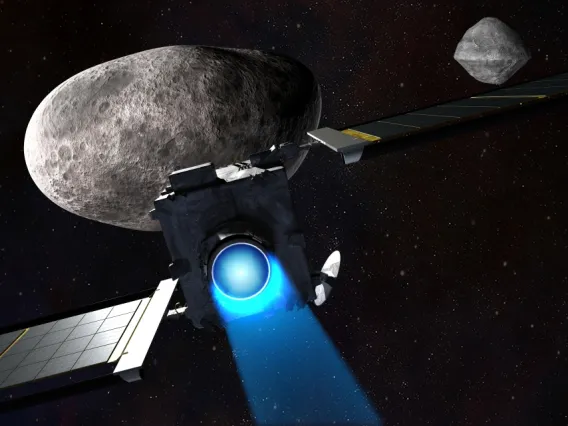
UArizona Spacewatch Discovered the Larger of the Twin Asteroids Targeted in NASA's Upcoming DART Mission Encounter
In 1996, the University of Arizona Spacewatch program discovered Didymos, the larger of the two asteroids that are the focus of NASA's upcoming DART mission encounter.
UArizona Spacewatch Discovered the Larger of the Twin Asteroids Targeted in NASA's Upcoming DART Mission Encounter
×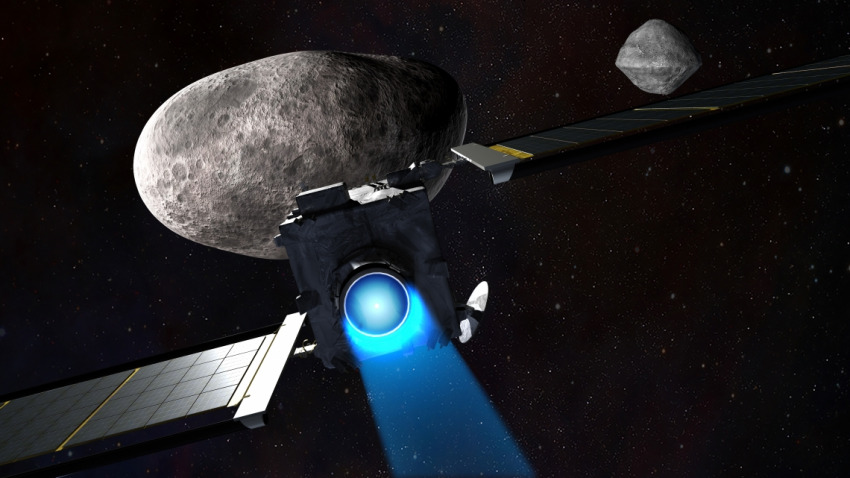
By Mikayla Mace Kelley, University Communications - September 19, 2022
On a spring night in 1996, a camera on the University of Arizona Steward Observatory's 36-inch telescope atop Kitt Peak captured three important images of a bright object sweeping across a backdrop of seemingly static stars.
The object turned out to be a half-mile-wide, potentially hazardous near-Earth asteroid, caught on camera by Joseph Montani, a member of the university's Spacewatch group in the Lunar and Planetary Laboratory. Originally dubbed 1996 GT, the asteroid would later be renamed Didymos – which is Greek for "twin" – at Montani's suggestion. The name was inspired by the discovery in 2003 that the asteroid has a small companion, only 525 feet across.
That companion – named Dimorphos, meaning having two forms – is the target of an upcoming NASA mission designed to test technology that could redirect asteroids that potentially threaten life on Earth.
Dimorphos and Didymos both orbit the sun, and the smaller of the pair orbits the larger one about once every 12 hours. Though Didymos and Dimorphos pose no threat to Earth, NASA identified Dimorphos as an ideal target to test asteroid redirection technology that could help protect Earth from future asteroid threats.
On Sept. 26, 2022, NASA's Double Asteroid Redirection Test, or DART, mission spacecraft will slam into Dimorphos, and scientists will closely study how the impact alters the smaller asteroid's orbit around Didymos. DART launched on Nov. 24, 2021.
Spacewatch is led by principal investigator Melissa Brucker. She is also on the science investigation team for DART. Spacewatch and other research groups plan to collect data on the light reflected from the two asteroids after impact.
"We'll take a long series of images to measure the brightness of the system over time. Didymos and Dimorphos will look brighter when they're next to each other than when one is in front. In a series of images, we will be able to determine how long it takes Dimorphos to orbit Didymos," Brucker said. "Working on this mission is very exciting. I've been working on near-Earth asteroid tracking for eight years, so being able to participate in the first planetary defense demonstration is a really great opportunity."
Spacewatch has long history of asteroid discovery
Spacewatch was founded by UArizona planetary scientists Tom Gehrels and Robert S. McMillan in 1980.
The original goal of Spacewatch was to survey and discover small objects orbiting the sun, such as asteroids and comets, to better understand the evolution of the solar system. Spacewatch started shifting focus in 1998 and now follows up on discoveries made by astronomical surveys, such as UArizona's Catalina Sky Survey, by monitoring the positions and movement of newly discovered potentially hazardous objects so that they do not become lost.
Spacewatch continues to use the Steward Observatory 0.9-meter (36-inch) telescope atop Kitt Peak, as well as the Lunar and Planetary Laboratory's 1.8-meter (72-inch) telescope, which has been operational on Kitt Peak since 2002.
New asteroids and comets are discovered by groups around the globe constantly, with astronomers slicing the sky into regions that telescopes survey multiple times a night, snapping images at each pass. Surveys capture each region three to four times a night.
Astronomers then compare the positions of moving objects to background stars in an image. They send the resulting measurements to the International Astronomical Union's Minor Planet Center, which takes the observations and determines orbits for the objects.
As one of the longest running asteroid tracking groups, Spacewatch can claim many firsts.
It was the first group to use a charge-coupled device, or CCD, camera to routinely survey the sky for comets and asteroids. It also claims the first CCD-discovered near-Earth asteroid, 1989 UP (now called 496816), and comet, dubbed 125P/1991 R2 Spacewatch. Spacewatch was also the first astronomical group to develop automated, real-time software for moving-object detection and the first to discover a near-Earth asteroid by software – 1990 SS (now called 11885 Summanus).
Between May 1984 and June 2022, using UArizona telescopes on Kitt Peak, Spacewatch submitted 15,777,248 astrometric records of asteroids and comets to the Minor Planet Center. Of those 151,805 were of 15,072 unique near-Earth objects, including 1,883 potentially hazardous objects.
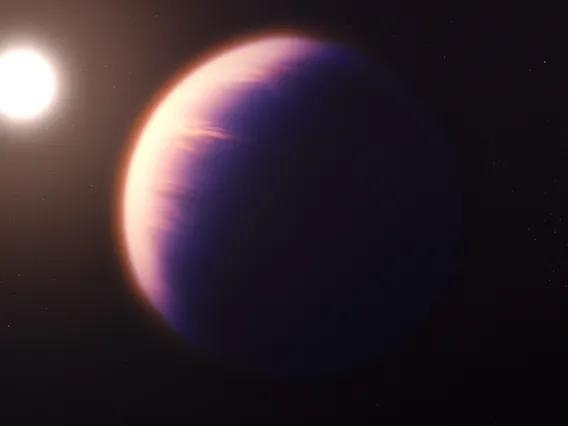
With Webb Space Telescope, UArizona Astronomers Help Detect Carbon Dioxide in Exoplanet Atmosphere
After years of preparation and anticipation, exoplanet researchers are ecstatic about the first official scientific observation of an exoplanet by NASA's James Webb Space Telescope.
With Webb Space Telescope, UArizona Astronomers Help Detect Carbon Dioxide in Exoplanet Atmosphere
×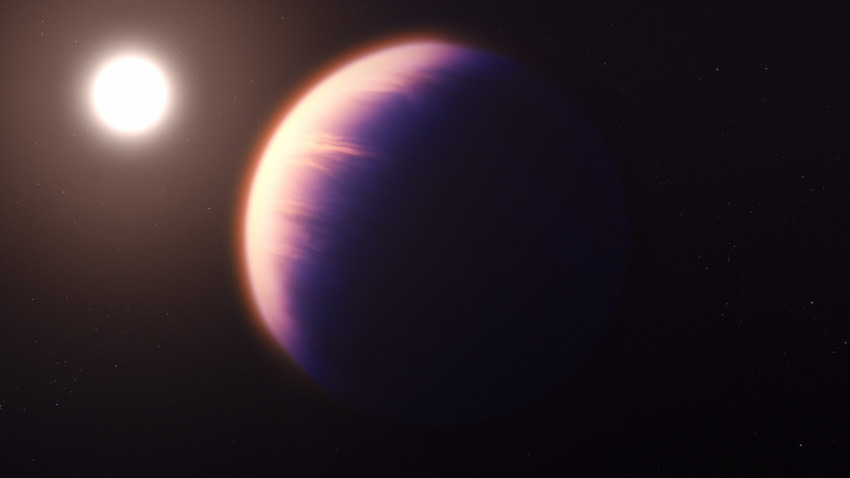
By Daniel Stolte, University Communications - August 25, 2022
Since NASA's James Webb Space Telescope began operations, breathtaking images offering never-before-seen views of the Milky Way have captured the imagination of people around the world. But for a team of astronomers at the University of Arizona, the most exciting finding so far is an unassuming diagram showing a squiggly line with a bump in it.
An international research team used Webb's Near-Infrared Spectrograph, or NIRSpec, to observe the exoplanet WASP-39 b. In the spectrum of the exoplanet's atmosphere, a small bump or "hill" in wavelengths between 4.1 and 4.6 microns presents the first-ever clear, detailed evidence of carbon dioxide in a planet outside the solar system.
"There are lots of things that absorb around that range," said Sarah Moran, a postdoctoral research associate in the UArizona Lunar and Planetary Laboratory and co-author of a forthcoming Nature paper detailing the discovery. "Based on observations with Hubble, we could only guess what the atmosphere of this planet is like, and we suspected it might carbon dioxide, but seeing this exact point in the JWST data, we know that it's CO2."
The discovery marks the first time carbon dioxide has been detected in the atmosphere of a planet outside the solar system, in this case in the atmosphere of WASP-39 b, a giant gas planet orbiting a sun-like star 700 light-years away. The discovery showcases the extraordinary capabilities of JWST and ushers in a new era of scanning the Milky Way for planets that may support life.
WASP-39 b is a hot gas giant with a mass roughly one-quarter that of Jupiter (about the same as Saturn) and a diameter 1.3 times greater than Jupiter. Unlike the cooler, more compact gas giants in our solar system, WASP-39 b orbits very close to its star – only about one-eighth the distance between the sun and Mercury – completing one circuit in just over four Earth days. The planet's discovery, reported in 2011, was made based on ground-based detections of the subtle, periodic dimming of light from its host star as the planet transits, or passes in front of the star.
Previous observations from other telescopes, including NASA's Hubble and Spitzer space telescopes, revealed the presence of water vapor, sodium and potassium in the planet's atmosphere. Webb's unmatched infrared sensitivity has now confirmed the presence of carbon dioxide as well.
Understanding the composition of a planet's atmosphere is important because it tells scientists something about the origin of a planet and how it evolved. Carbon dioxide molecules specifically contain information about the way a planet formed, for example how much gaseous material was used to form a gas giant planet.
"Previous observations with radio telescopes allowed us to see the individual ingredients that go into making planets, but now we can really start pulling apart what they look like after planet formation," said paper co-author Thomas Beatty, a former assistant research professor in UArizona's Steward Observatory who is now a faculty member at the University of Wisconsin.
"You could say we have seen the flour, the eggs and the butter sitting on the counter, but until the JWST became operational, we haven't been able to actually pick apart the cake and figure out how it's put together," Beatty said.
No observatory has ever measured such subtle differences in brightness of so many individual colors across the 3 to 5.5-micron range in an exoplanet transmission spectrum before. Access to this part of the spectrum is crucial for measuring abundances of gases like water and methane, as well as carbon dioxide, all of which are thought to exist in many different types of exoplanets.
Filtered starlight
Transiting planets like WASP-39 b, whose orbits we observe edge-on rather than from above, can provide researchers with ideal opportunities to probe planetary atmospheres. During a transit, some of the starlight is eclipsed by the planet completely – causing the overall dimming – and some is transmitted through the planet's atmosphere. Because different gases absorb different combinations of colors, researchers can analyze small differences in brightness of the transmitted light across a spectrum of wavelengths to determine exactly what an atmosphere is made of. With its combination of inflated atmosphere and frequent transits, WASP-39 b is an ideal target for this technique known as transmission spectroscopy . While JWST is not designed to spot life on other planets – if it exists – it is poised to identify potentially habitable planets, according to Beatty.
"There probably are a lot of places out there that are just lumps of rock with no atmosphere, so distinguishing between those and a world that does have an atmosphere is important at this stage," he said. "At this point, we have no idea we see all these planets that are roughly the same size of Earth, and for all we know, they could be worlds as hostile as Venus or as habitable as Earth."
Early release science
This NIRSpec observation of WASP-39 b is just one part of a larger investigation that includes observations of the planet using multiple Webb instruments, as well as observations of two other transiting planets. The investigation, which is part of the Early Release Science program, was designed to provide the exoplanet research community with robust Webb data as soon as possible.
"The goal is to analyze the Early Release Science observations quickly and develop open-source tools for the science community to use," explained Vivien Parmentier, a co-investigator at Oxford University. "This enables contributions from all over the world and ensures that the best possible science will come out of the coming decades of observations."
According to co-author Everett Schlawin, an assistant research professor at UArizona's Steward Observatory, many steps are necessary to tease out a result like the this from the raw data recorded by the space telescope. When starlight passes through a planet's atmosphere, it is spread out into its different colors, which the researchers have to convert into what is known as a light curve.
"There is a lot of noise in the data because you have all this starlight come at you, but you only want to analyze the tiny sliver of light that passed through the atmosphere," he said.
According to Moran, an important part of this work involves creating computer models that take into account various atmospheric compositions and conditions.
"To borrow the analogy of the cake, we know that you need eggs and butter and flour, but the tricky part is getting the balance of those things right," Moran said. "For example, we put this amount of hydrogen, this amount of CO2 or this amount of water our models. We then play with the balances of those ingredients and the temperature to see which 'recipe' best matches the observational data to understand what the planet is like."
Not surprisingly, it took the team a while to really be sure of the data, Schlawin said, but the end results surpassed expectations.
"When I showed the very first image to colleagues, they asked, 'Am I looking at your modeling data or the actual data from the telescope?' – that's how good these observations are," he said.
Beatty said the difference in the quality of the JWST data compared to what was previously available is like "jumping from an old-school TV to a 4K high-definition TV."
"Being able to see these things suddenly in this sharp detail is very exciting," he said. "I think our understanding of exoplanets is going to be completely different five years from now than what it is today."
UArizona exoplanet researchers are particularly excited about what the new space observatory will reveal about new categories of planets that have no counterpart in the solar system, like super Earths – worlds that rival gas giants in size but whose composition resembles that of terrestrial planets. The observations reported here are indicative of Webb's ability to detect and measure carbon dioxide in exoplanet atmospheres, whether they be thick, puffy atmospheres of giants like WASP-39b or tenuous gas envelopes of small, rocky planets.
"We really have no idea how many of these planets have atmospheres at all, which is definitely the first thing you would need to form life on the surface of the planet," said Megan Mansfield, a NASA Sagan Fellow at Steward Observatory who also is a co-author of the Nature paper. "We are going to be able to start taking these first steps to look for life on other planets."
The UArizona contributions to this effort included atmospheric chemistry studies by Mark Marley, head of the Lunar and Planetary Laboratory. The James Webb Space Telescope is the world's premier space science observatory. Webb will solve mysteries in our solar system, look beyond to distant worlds around other stars, and probe the mysterious structures and origins of our universe and our place in it. Webb is an international program led by NASA with the European Space Agency and the Canadian Space Agency.
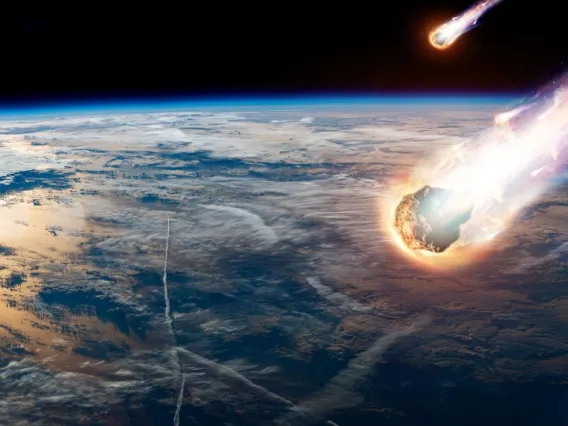
More Than One Asteroid Could Have Spelled Doom for the Dinosaur
A newly discovered impact crater below the seafloor hints at the possibility that more than one asteroid hit Earth during the time when dinosaurs went extinct.
More Than One Asteroid Could Have Spelled Doom for the Dinosaur
×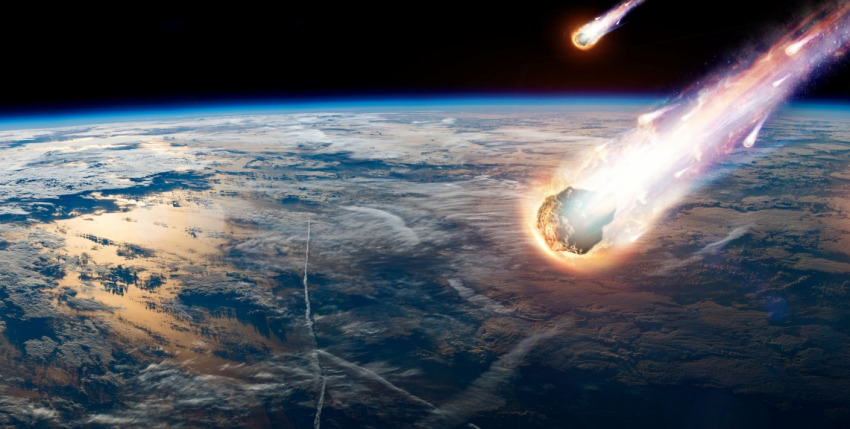
By Daniel Stolte, University Communications, and Heriot-Watt University - August 17, 2022
Scientists have found evidence of an asteroid impact crater beneath the North Atlantic Ocean that could force researchers to rethink how the dinosaurs reached the end of their reign.
The team believes the crater was caused by an asteroid colliding with Earth around 66 million years ago – around the same time that the Chicxulub asteroid hit Earth off the coast of today's Yucatan, Mexico, and wiped out the dinosaurs.
Spanning more than 5 miles in diameter, the crater was discovered using seismic measurements, which allow scientists to probe what lies deep below Earth's surface.
Veronica Bray, a research scientist in the University of Arizona Lunar and Planetary Laboratory, who specializes in craters found throughout the solar system, is a co-author of a study in Science Advances detailing the discovery.
Named after a nearby seamount, the Nadir crater is buried up to 1,300 feet below the seabed about 250 miles off the coast of Guinea, West Africa. The team believes the asteroid that created the newly discovered Nadir crater could have formed by breakup of a parent asteroid or by a swarm of asteroids in that time period. If confirmed, the crater will be one of less than 20 confirmed marine impact craters found on Earth.
What impact would the asteroid have had?
Bray used computer simulations to determine what kind of collision took place and what the effects might have been. The simulations suggest the crater was caused by the collision of a 1,300 foot-wide asteroid in 1,600 to 2,600 feet of water.
"This would have generated a tsunami over 3,000 feet high, as well as an earthquake of more than magnitude 6.5," Bray said. "Although it is a lot smaller than the global cataclysm of the Chicxulub impact, Nadir will have contributed significantly to the local devastation. And if we have found one 'sibling' to Chicxulub, it opens the question: Are there others?”
The estimated size of the asteroid would put it roughly on par with asteroid Bennu, the target of the UArizona-led NASA asteroid sample return mission OSIRIS-REx. According to Bray's calculations, the energy released from the impact that caused the Nadir crater would have been around 1,000 times greater than the tsunami caused by the underwater eruption of the Hunga Tonga-Hunga Ha'apai volcano in the Polynesian country of Tonga on Jan. 15.
"These are preliminary simulations and need to be refined when we get more data," Bray said, "but they provide important new insights into the possible ocean depths in this area at the time of impact."
What does the crater look like?
Uisdean Nicholson, a geologist at Heriot-Watt University in Edinburgh, discovered the crater somewhat by accident, while examining seismic reflection data from the seabed during a research project dedicated to seafloor spreading, the geologic process that caused the African and American continents to drift apart, thereby opening the Atlantic Ocean.
"I've interpreted lots of seismic data in my time, but had never seen anything like this. Instead of the flat sedimentary sequences I was expecting on the plateau, I found an 8.5-kilometer depression under the seabed, with very unusual characteristics," Nicholson said. "It has particular features that point to a meteor impact crater. It has a raised rim and a very prominent central uplift, which is consistent for large impact craters.
"It also has what looks like ejecta outside the crater, with very chaotic sedimentary deposits extending for tens of kilometers outside of the crater," he added. "The characteristics are just not consistent with other crater-forming processes like salt withdrawal or the collapse of a volcano."
The asteroid crashed around same time as the dinosaur killer
"The Nadir Crater is an incredibly exciting discovery of a second impact close in time to the Cretaceous–Paleogene extinction," said study co-author Sean Gulick, an impact expert at the University of Texas at Austin. "While much smaller than the extinction causing Chicxulub impactor, its very existence requires us to investigate the possibility of an impact cluster in the latest Cretaceous."
While the seismic data indicate that the sediments impacted by the asteroid correspond with the Cretaceous-Paleogene boundary – a sedimentary layer demarcating the end of the Cretaceous period and last known occurrence of dinosaurs – there is some uncertainty about the precise time of impact, limited by the resolution of the data.
"Despite 4 billion years of impactors hitting Earth, only 200 have been discovered," Gulick said. "It is thus exciting news whenever a new potential impact is discovered, especially in the hard-to-explore marine environment."
Nicholson has applied for funding to drill into the seabed to confirm that it's an asteroid impact crater and test its precise age.
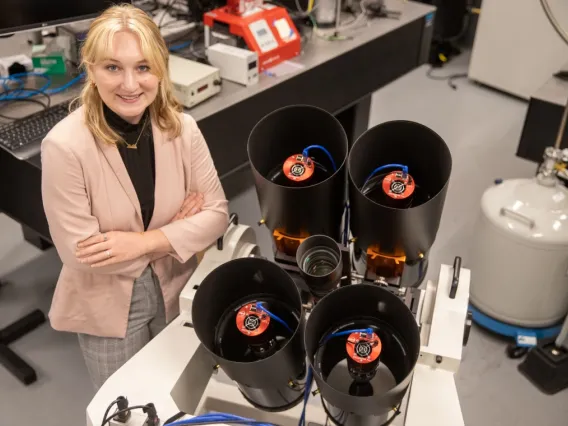
As Reflective Satellites Fill the Skies, UArizona Students Are Making Sure Astronomers Can Adapt
University of Arizona students have completed the first comprehensive brightness study to characterize mega-constellation satellites cluttering the skies.
As Reflective Satellites Fill the Skies, UArizona Students Are Making Sure Astronomers Can Adapt
×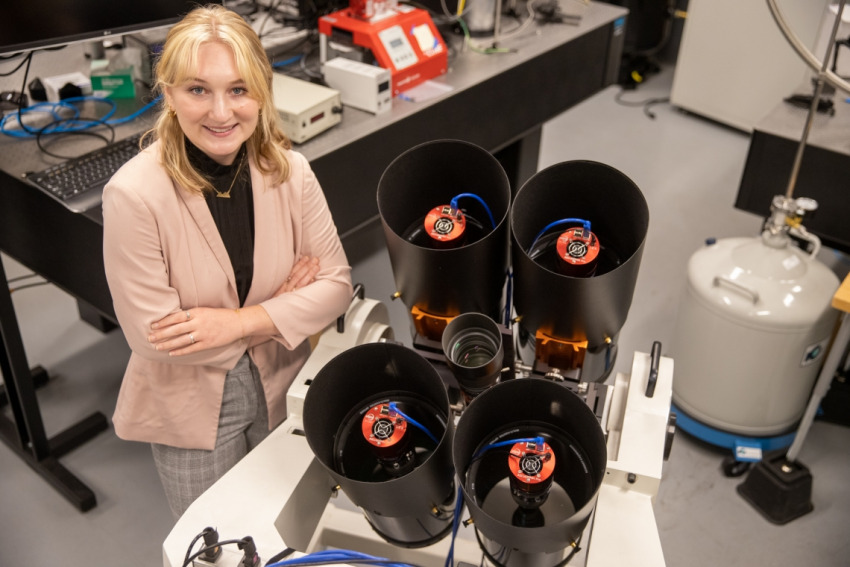
By Mikayla Mace Kelley, University Communications - August 2, 2022
As satellites crawl across the sky, they reflect light from the sun back down to Earth, especially during the first few hours after sunset and the first few hours before sunrise. As more companies launch networks of satellites into low-Earth orbit, a clear view of the night sky is becoming rarer. Astronomers, in particular, are trying to find ways to adapt.
With that in mind, a team of University of Arizona students and faculty completed a comprehensive study to track and characterize the brightness of satellites, using a ground-based sensor they developed to measure satellites' brightness, speed and paths through the sky. Their work could be helpful for astronomers, who, if notified of incoming bright satellites, could close the shutters of their telescope-mounted cameras to prevent light trails from tainting their long-exposure astronomical images.
The research team was led by professor of planetary sciences Vishnu Reddy, who also co-leads – with study co-author and professor of systems and industrial engineering Roberto Furfaro – the university's Space Domain Awareness lab, which tracks and characterizes all kinds of objects orbiting Earth and the moon.
Grace Halferty, a senior graduating this summer with a bachelor's degree in aerospace and mechanical engineering, is the lead author of the study, which is published in Monthly Notices of the Royal Astronomical Society. The study details how the team created a satellite tracking device to measure the brightness and position of SpaceX Starlink satellites and compared those observations to government satellite tracking data from the Space Track Catalog database.
"Until now, most photometric – or brightness – observations that were available were done by naked eye," Halferty said. "This is one of the first comprehensive photometric studies out there to go through peer review. The satellites are challenging to track with traditional astronomical telescopes, because they are so bright and fast-moving, so we built what's basically a small sensor with a camera lens ourselves because there was nothing off the shelf available."
The team made 353 measurements of 61 satellites over two years and found that the position of Starlink satellites as recorded in the government's Space Track Catalog only differed by an average of 0.3 arc seconds from the UArizona calculations. An arc second on the sky is about the size of a dime held 2.5 miles away. The tiny difference is probably due to natural lag times in the government data, Reddy said. Because that data is based on estimated orbits calculated days earlier, rather than on real-time observations, positioning errors can build up.
"This suggests that there is hope that astronomers can use these data to close the shutter of their telescopes in time amid the growing chaos in the skies above," Reddy said.
A stellar traffic jam
Starlink is a large network of satellites, also called a mega constellation, operated by SpaceX with the goal of providing global internet coverage. SpaceX started launching Starlink satellites in 2019. Today, more than 2,700 Starlink satellites have launched – a fraction of the intended total of 42,000 satellites.
Other examples of satellite constellations include 31 GPS satellites and 75 iridium satellites for communication. Other entities have plans to launch more satellites into low and medium Earth orbit in the next few years. Amazon, for example, plans to launch 3,000 satellites, and the Chinese government plans to launch 13,000. These satellites will orbit no higher than 22,000 miles above Earth.
The problem with these satellites is that they require power harvested from solar panels, which can reflect sunlight at ground-based telescopes and, in turn, impact astronomical observations from telescopes around the world. About 30% of all telescope images will be impacted by at least one satellite trail once the Starlink constellation is complete, said research team member Tanner Campbell, a graduate research assistant in the Department of Aerospace and Mechanical Engineering.
"As other constellations are added, the problem will only get worse for ground-based astronomical surveys," he said.
These satellites are even more reflective right after launch, while they are still relatively low and tightly clustered before they spread throughout their orbit over time. They are often as bright as Saturn or Jupiter, two of the brightest objects in the night sky. As they maneuver into higher orbits, they become slightly fainter.
A moving target
SpaceX has deployed a few different methods to darken its Starlink satellites. For example, VisorSat satellites rely on a shade to block additional sunlight, making them 1.6 times fainter. DarkSat satellites, on the other hand, rely on an anti-reflective coating that makes them 4.8 times fainter. However, DarkSats got too hot, so SpaceX moved away from that specific method. Since August 2021, all Starlink satellites are VisorSats.
"While these modifications are steps in the right direction, they also don't dim the satellites enough for astronomical surveys," said research team member Adam Battle, a graduate student studying planetary science.
In July, SpaceX announced new strategies. One involves mirrors that reflect sunlight away from Earth and another involves using darker building materials. Reddy's team plans to study how effective these methods are at reducing sunlight reflection back to Earth.
While knowing exactly where satellites are is helpful to astronomers, the act of shutting the cameras adds overhead costs for telescope operations. Surveys become less efficient when astronomers have to close the shutter or throw away contaminated images. For example, a survey that would take five years to complete could take 10% to 20% more time if survey efficiency is down. Costs will continue to increase as more satellites are launched, Reddy said.
The team plans to build upon its success by studying the brightness of the latest generation of Starlink satellites in four different colored filters – the same ones used in astronomical surveys of the sky to tease out different information from stars, planets and more. To achieve this, the team has worked with Tucson-based small business Starizona to build a sensor that can take pictures of satellites in four colors simultaneously.
"Working with local small businesses is a win for us as it provides our students an opportunity to rapidly prototype and bring a new system online," Reddy said.

